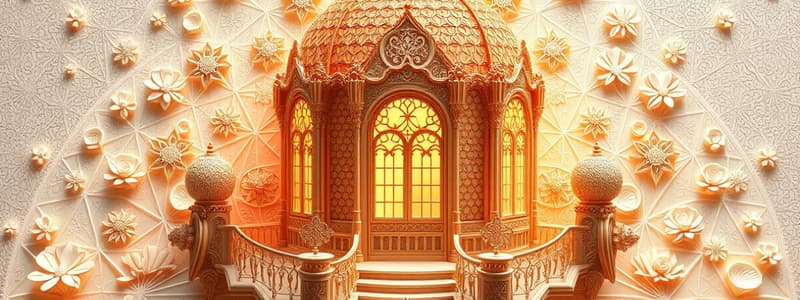Podcast
Questions and Answers
What is the purpose of computer software in 3D printing?
What is the purpose of computer software in 3D printing?
To direct the printer head how far across and how far up to move on the number plane.
What materials can be used instead of traditional ink in 3D printing?
What materials can be used instead of traditional ink in 3D printing?
Plastic, glass, metal, wood, rubber, or wax.
What is a 'slice' in 3D printing?
What is a 'slice' in 3D printing?
- A feature of the software
- A single layer of printing (correct)
- A type of material used
- An error during printing
Match the following applications of 3D printing with their examples:
Match the following applications of 3D printing with their examples:
3D printers only use plastic as a material.
3D printers only use plastic as a material.
What happens after one full layer is printed in 3D printing?
What happens after one full layer is printed in 3D printing?
What is the purpose of a number plane in 3D printing?
What is the purpose of a number plane in 3D printing?
What materials can be used in 3D printing?
What materials can be used in 3D printing?
Each layer in 3D printing is called a ___.
Each layer in 3D printing is called a ___.
In 3D printing, each slice is required to be the same shape as the previous one.
In 3D printing, each slice is required to be the same shape as the previous one.
Which of the following is NOT an application of 3D printing?
Which of the following is NOT an application of 3D printing?
Flashcards are hidden until you start studying
Study Notes
3D Printing and Number Plane Geometry
- Number Plane Basis: Number plane geometry is fundamental for 3D printing operations, involving a virtual plane with x and y axes.
- Layering Process: After each layer is printed, the platform moves downward to allow the printing of the next layer, known as a ‘slice’.
- Slice Characteristics: Each slice, typically around 0.2 mm thick, can vary slightly in shape from the previous one.
- Material Versatility: Multiple materials can be utilized in 3D printing, including plastic, glass, metal, wood, rubber, and wax.
- Applications: 3D printing produces diverse objects such as artificial body parts (e.g., hands, legs, ears), scale models of buildings, and parts for vehicles or aircraft.
Chapter Overview
- Content Sections: The chapter includes topics on linear relationships, rules, tables, and graphs, focusing on concepts relevant to number planes.
- Learning Outcomes: Key areas covered involve plotting linear relationships, solving equations both algebraically and graphically, and verifying solutions.
- Curriculum Alignment: The content aligns with the Australian Curriculum under the NUMBER AND ALGEBRA strand, emphasizing the understanding of linear and non-linear relationships.
3D Printing and Number Plane Geometry
- Number Plane Basis: Number plane geometry is fundamental for 3D printing operations, involving a virtual plane with x and y axes.
- Layering Process: After each layer is printed, the platform moves downward to allow the printing of the next layer, known as a ‘slice’.
- Slice Characteristics: Each slice, typically around 0.2 mm thick, can vary slightly in shape from the previous one.
- Material Versatility: Multiple materials can be utilized in 3D printing, including plastic, glass, metal, wood, rubber, and wax.
- Applications: 3D printing produces diverse objects such as artificial body parts (e.g., hands, legs, ears), scale models of buildings, and parts for vehicles or aircraft.
Chapter Overview
- Content Sections: The chapter includes topics on linear relationships, rules, tables, and graphs, focusing on concepts relevant to number planes.
- Learning Outcomes: Key areas covered involve plotting linear relationships, solving equations both algebraically and graphically, and verifying solutions.
- Curriculum Alignment: The content aligns with the Australian Curriculum under the NUMBER AND ALGEBRA strand, emphasizing the understanding of linear and non-linear relationships.
Studying That Suits You
Use AI to generate personalized quizzes and flashcards to suit your learning preferences.



